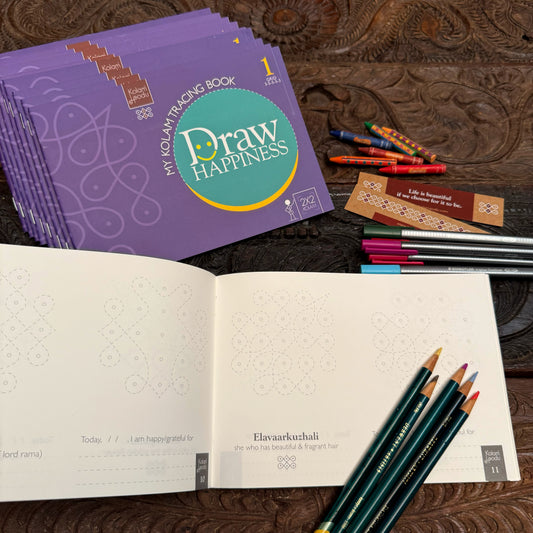Kolam, an intricate art form practiced with regional variations across India, offers children a holistic learning experience. Engaging in kolam creation enriches cognitive development through improved visual perception and spatial reasoning. It hones fine motor skills, fosters creativity, and enhances focus. Furthermore, kolam encourages an appreciation for cultural traditions and promotes emotional well-being. This art form serves as a canvas for young minds, celebrating both creativity and cultural heritage, uniting different regions under the beautiful practice of kolam.
Kolam, with its mesmerizing artistry, presents a treasure trove of benefits for children. Here's how kolam provides a wholesome learning experience and contributes to children's growth:
- Cognitive Development: Delving into kolam creation supports cognitive growth in children. It enhances their visual perception, spatial reasoning, and problem-solving skills. Observing patterns, shapes, and colors hones their ability to analyze and interpret visual information, a valuable asset in various academic subjects.
- Fine Motor Skills: The intricate art of kolam involves precise hand movements and coordination. As children draw intricate designs, connect dots, and fill in colors, their fine motor skills are refined and strengthened. These skills lay a solid foundation for activities like writing, drawing, and other detailed tasks.
- Creativity and Artistic Expression: Kolam serves as a fertile ground for children to unleash their creativity and artistic flair. They can explore diverse designs, experiment with vibrant colors, and create unique patterns. This artistic expression fosters imagination encourages thinking outside the box, and boosts self-confidence.
- Focus and Concentration: The art of designing kolams demands unwavering focus and attention to detail. Children develop the ability to concentrate wholeheartedly on the task at hand, fostering mindfulness that permeates into other aspects of their lives. Improved focus positively impacts academic performance and overall effectiveness in various endeavors.
- Cultural Appreciation: At the heart of kolam lies the rich tapestry of South Indian culture. As children engage in kolam creation, they develop a profound appreciation for cultural traditions, aesthetics, and symbols. They discover the significance of different patterns and the occasions where kolams hold special meaning, nurturing an understanding and respect for cultural diversity.
- Emotional Well-being: The act of creating kolams can be a meditative and calming experience for children. It becomes an expressive outlet, enabling them to find solace in the artistic process. The act of designing kolams can alleviate stress, promote relaxation, and enhance emotional well-being.
In summary, kolam offers a holistic learning journey for children, stimulating their cognitive abilities, refining fine motor skills, fostering creativity, and nurturing cultural understanding. It provides a canvas for artistic expression, instills focus, and contributes to their overall well-being—a vibrant celebration of creativity and tradition that inspires young minds.
Kolam in Tamil Nadu is muggulu in Andhra Pradesh and Telangana, rangoli in Maharashtra, hase and rangavali in Karnataka, alopana in Bengal, to name a few.
Life is beautiful if we choose for it to be. Let's draw happiness!







